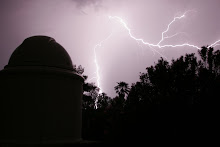
Today was the first day of the 2008 Advanced Imaging Conference. I'm here in San Jose for the 3rd year, and enjoying every minute of it. The sessions today were primarily product workshops. I attended 4 of them, including:
-John Smith and Steve Walther discussing CCD Autopilot and CCD Navigator;
-Matt Thomas discussing CCD Commander;
-Doug George on MaximDL;
-Stan Moore on CCD Stack;
-The Bisque Brothers on the upcoming TheSky X Professional.
Of course I also saw a bunch of friends. There are a bunch of us from Tucson here, including Dean S., Alistair, Steve, Dean K., Scott, and Adam.
Dean and I are logging in back home and running our scopes at night. It's a lot of fun to be sitting in a CA hotel room and running the telescope at home! The moon's full but I'm getting some decent H-alpha data anyway.
Here's an image that I took over several nights back in October. It's emission nebula NGC 1491, which lies in Perseus. Narrowband filters were used, and mapped with the Hubble pallet (SII=Red, Ha=Green, OIII=Blue). I took 4 hours worth of 10-minute subframes with each filter, for total exposure time of 12 hours. Click here to see more information and a larger version of this image.
One of the speakers today referred to our hobby as a "blend of science and art". This is a good example. The narrowband filters are not "true color" (there's not really any such thing as "true color", but it's basically what we see visually), since they represent only a 60 angstrom slice of the spectrum. H-alpha and SII both generally lie in the red region, and OIII is closer to the green. So when astroimagers put together an image using narrowband filters, we often have to create a false color mapping to differentiate the fine details between the filters. I often use the "Hubble Pallet", as I did here, which is based on a color scheme often used for image processing on data taken with the Hubble Space Telescope. The data has also been "stretched" to emphasize various contrast differences. So basically, I have taken scientifically accurate data and presented it with some artistic perspective.

No comments:
Post a Comment